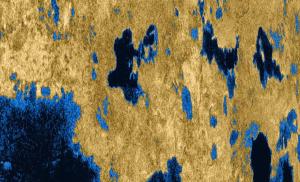Blog
Wave the Titanic
22 June 2014
 NASA/JPL/USGS
NASA/JPL/USGSSaturn’s largest moon Titan is in some ways very similar to Earth. Sure, it is significantly colder, and has a much thicker atmosphere, but it has something no other world besides Earth. Lakes and seas. These are not water lakes, but methane. With a surface temperature of about 94 K, and a thick atmosphere, Titan is perfect for a methane cycle similar to the water cycle on Earth. On titan, methane gas exists as a vapor in the atmosphere, which can condense and fall as rain. This collects as rivers and lakes on the surface of the moon.
With the Cassini mission we’ve been able to map some of the lakes and seas on Titan. They resemble the shape of lakes we see here on Earth. But one thing they don’t seem to have is waves. Some of Titan’s lakes are larger than the Great Lakes of Earth, which can experience sizable waves. But radar measurements of Titan’s lakes have found no evidence of waves. Since Titan has a lower gravity than Earth, waves should actually be more likely. It’s been calculated that a breeze of only 2 – 3 km/hr would be enough to produce measurable waves. We know that such wind levels exist on Titan, so the lack of waves is a bit of a mystery.